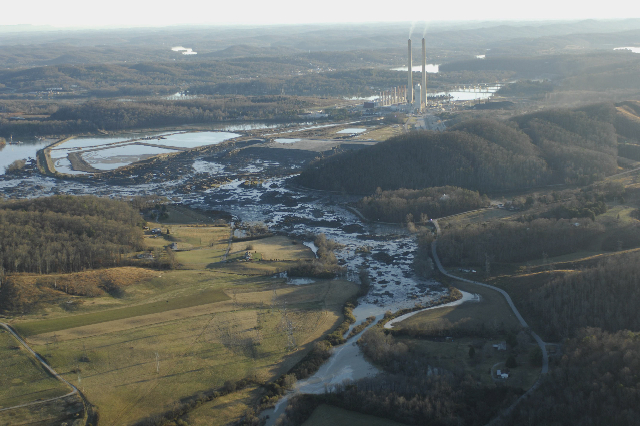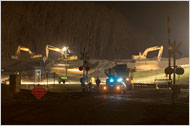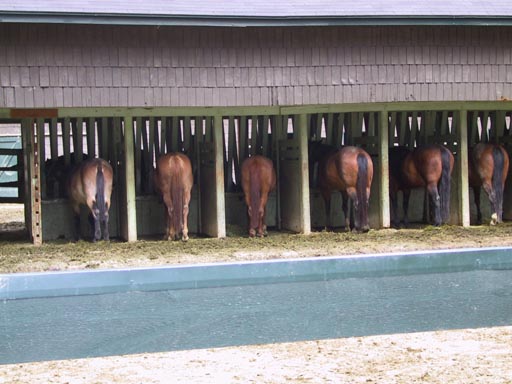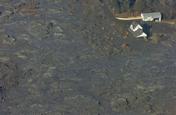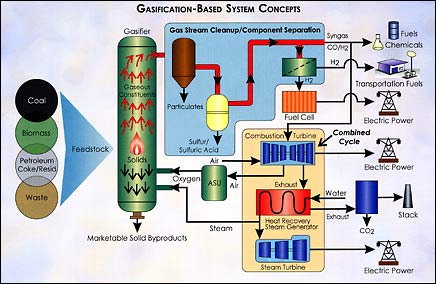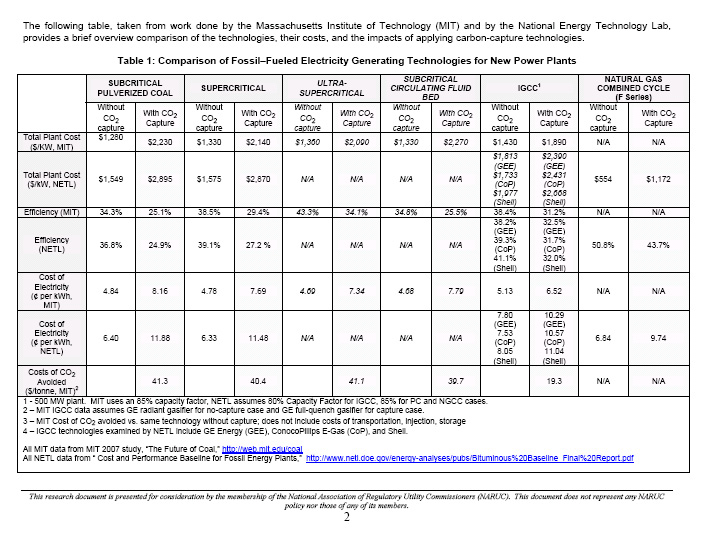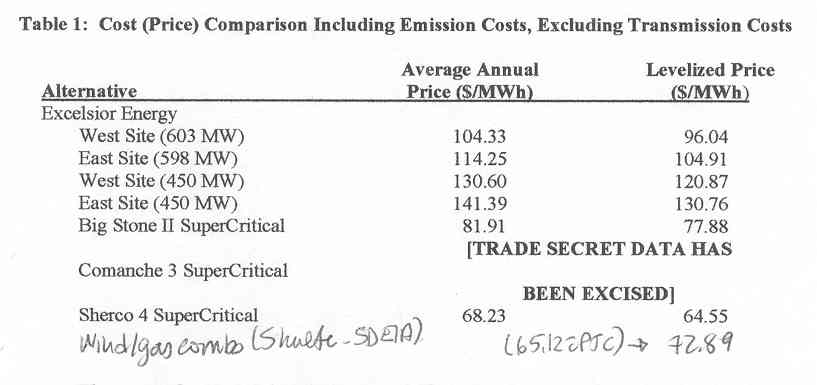TVA coal ash slide – UPDATES
December 27th, 2008
The only good news in this is that the media is picking this up, it’s not going to be “disappeared.”
From the “field” or from the slime, muck & yuck, here are updates. Special thanks to United Mountain Defense, John Walthen, Nicholas Mann, Tom Swinford, Chris Irwin, Donna Lisenby, Dot Griffith, and all those doing tremendous work getting the word and pictures out (whose names haven’t shown up in the emails I’ve received). This is a clear example of the importance of the internet.
Here’s from The Tennessean:
Would you believe 5.4 million cubic yards? Can you even imagine that?
A video from the scene by people taking water samples on the Emory River:
There is a great collection of photos on Photobucket:
A general view of the devastation, being downplayed by TVA and the coal industry:
Here you can watch the cops clearing out the area (at the end), can’t have this showing up on YouTube, don’t cha know:
And this photo by Dot Griffith puts it all together:
TVA ash spill in NYT
December 26th, 2008
Clean coal? Ask anyone near TVA’s Kingston Plant… THERE IS NO SUCH THING AS CLEAN COAL!
Yesterday’s New York Times had the TVA ash spill front and center:
Clean up is going to be a long, slow, costly process, and can it even be cleaned up?
And here’s a review of the “Issues of Hazards” raised in the article:
Similarly, a 2006 study by the federally chartered National Research Council found that these coal-burning byproducts “often contain a mixture of metals and other constituents in sufficient quantities that they may pose public health and environmental concerns if improperly managed.” The study said “risks to human health and ecosystems” might occur when these contaminants entered drinking water supplies or surface water bodies.
In 2000, the Environmental Protection Agency proposed stricter federal controls of coal ash, but backed away in the face of fierce opposition from utilities, the coal industry, and Clinton administration officials. At the time, the Edison Electric Institute, an association of power utilities, estimated that the industry would have to spend up to $5 billion in additional cleanup costs if the substance were declared hazardous. Since then, environmentalists have urged tighter federal standards, and the E.P.A. is reconsidering its decision not to classify the waste as hazardous.
And regarding coal ash dump pollution:
Another 2007 E.P.A. report said that over about a decade, 67 towns in 26 states had their groundwater contaminated by heavy metals from such dumps.
Award for Todd Goodman, Delmarva Power
December 23rd, 2008
We sent this post out as a Green Delaware Alert to test the new consolidated email list, and WHEW, this has done a lot for Green Delaware fundraising! Keep it comin’, folks! To donate to Green Delaware, you can use PayPal (CLICK HERE FOR PAYPAL) or send to Green Delaware, P.O. Box 69, Port Penn, Delaware 19731. Thanks to all those who got fired up and nominated others for a Horse’s Ass Award. Feel free to leave suggestions in the Comment section (you have to click on the headline to get into the individual post, and the comment section is at the bottom, it’s moderated, but I approve everything but spam). CLICK HERE FOR PAYPAL FOR GREEN DELAWARE. And click here for the Green Delaware Newsletter – December 2008.
Back to Todd Goodman, Attorney for Delmarva Power, and his Horse’s Ass Award…
Today’s Horse’s Ass award goes to BADMAN Todd Goodman, counsel for Delmarva Power. He put on a superb performance December 3, and deserves this award, no doubt!
It took a long time to get the transcript. I asked how long it would take, and was told 7 days. Two weeks later, I started inquiring, and both Alan and I had a couple phone calls and emails with the “Nickerson twins,” Karen and Donna, staff at the PSC, a bit of fisticuffs, and finally, here it is.
So here’s what happened. I went to a hearing on the Delmarva Power Integrated Resource Plan, a PUBLIC hearing that is, and he tried to keep me from testifying. It was grossly offensive, saying that I was representing Green Delaware, which I was not, I have plenty of my own to say, thank you… and Muller can assuredly speak for himself, when he’s not wearing a gag.
Goodman was a certified horse’s ass. He accused me of practicing law without a license (by testifying as Carol A. Overland in an IRP docket based on what I know from MN IRPs?), that I should not be allowed to testify because I don’t live in Delaware (excuse me, I live in Minnesota and Delaware, so there, pppppppffffffffbbt!), he tried everything he could think of, smirking all the way. What is he afraid of? It was so extreme that it made me wonder if his company knows what he’s doing. Does Delmarva Power approve of and promote conduct like this? Unreal…
Throughout, the Public Advocate sat there, not even at the table, sat behind in the peanut gallery, silent. The good news is that PSC Commissioner Jeff Clark was there, witness to it all. That makes it worthwhile, Delmarva exposed, behaving that way before a regulator. As a bull-headed Minnesota energy regulator/energy wonk/worthy opponent said, upon hearing this story:
Re: Delmarva Power — haven’t those folks learned that it really doesn’t help them to try to screw with you like that? A) You always have useful things to say and for folks to consider, resulting in better decisions; and B) it just pisses you off and makes you want to make things 10 times worse for them.
Yup, that it does, and yes-siree, it will indeed be 10 times worse for them.
Here’s the transcript, Todd Goodman in technicolor:
If you want to have another good laugh, check out the Delmarva Power IRP.
This 2006 IRP is on the third iteration because they couldn’t come up with one that the PUC would accept, it was deficient, and deficient again, and so now this third one was submitted in November. On December 15, rather than file their 2008 IRP they send a letter saying they want to use this 2006 amended IRP filing as the one that’s due in December 2008. How lame can we get? I hope the PSC gives them the gong on that idea.
TVA coal ash spews over Tennessee
December 23rd, 2008
Yesterday the TVA’s Kingston coal plant’s coal ash sludge pit blew a sidewall and spewed all over near Harriman, Tennessee, into the Tennessee River. over 400 acres were covered in sludge. There was at least 2.6 million cubic yards or 500 million gallons of coal ash and an entire watershed is affected. That’s really toxic stuff, coal ash. Lots of heavy metals are left, lots of hazardous chemicals, there’s mercury, lead, arsenic, and is this coal slag also radioactive like much in the Dakotas? How will they deal with this?
IF YOU WERE HIT BY THIS COAL ASH FLOOD- CALL TVA: 865-717-4006
Lots of links now, I’m updating now and then.
It’s now in The Tennessean:
Here’s an article with photos and video:
From WYMT:
Here’s Volunteer TV with some more aerial video (and the odd comment that “The damage is done, all that’s left now is the clean up!” Oh… OK…
From WTVC – Chattanooga:
From WMCTV – Memphis:
They don’t know what caused it and yet say there is no danger from the other sludge pits in the area… say what?
TVA ash pond breach: Resident says area has ‘changed forever’
The sludge has encroached 10 feet farther into his yard than the usual winter pool level, and the scenic landscape is replaced by 15-foot-high piles of ash.
“It’s changed forever, I don’t see how this can be brought back,” Copeland said.
Here’s Dave Cooper’s post on Ruminations from the Distant Hills:
From YouTube, the video from Knoxnews of this disaster (this is a must see):
This could be one of the worst environmental disasters ever. One more example of the dangers and inherent problems with burning coal. Does the TVA have a “get out of jail free” card, like nuclear does in Price-Anderson Act? How can the clean up this mess, and how will the coal plant be held accountable? How will the coal industry prevent this from happening again?
It’s not like this is something new. Thanks to It’s Getting Hot in Here for a look at history, least we forget…
It happened in Martin County, Kentucky, in 2000:
It happened in Logan County, West Virginia, where 125 people died, 1,200+ were injured and over 4,000 were homeless:
I’m looking for updates on this… and I found them — try “TVA” and “flood” and not “TVA” and “coal ash.” Seems it’s not well acknowledged that it’s coal ash!
And here we go national:
SF Chronicle: Dike bursts in Tenn. damaging a dozen homes (AP)
By Josh Flory (Contact)
Tuesday, December 23, 2008The ash that burst out of a TVA retention pond on Monday is the sort of waste that has gotten scrutiny from federal regulators and lawmakers in recent months.
The mixture in question was made of water and fly ash, a fine particle that’s one of the by-products of burning coal to generate electricity. The ash is collected by scrubbers that aim to clean up emissions from power-plant smokestacks, and it includes trace elements of materials like arsenic and lead.
In June, a subcommittee in the U.S. House of Representatives held an oversight hearing to examine how the government should address the health and environmental risks of coal combustion waste, including fly ash.
Mary Fox, an assistant professor in the Department of Health Policy and Management in the Johns Hopkins Bloomberg School of Public Health, testified at this summer’s hearing and said in written testimony that “Risks to human health are increased if people are exposed to coal combustion waste.”
In an interview on Monday, Fox said she was reassured about reports that the Kingston spill was a release of wet ash because that means it wouldn’t have gotten into the air as dust.
Fox said generally the concern about fly ash is in regard to long-term exposures – from leaching into the groundwater, for example – and said that when it comes to a spill, the main exposure issues initially will be for people who are cleaning up the mess.
“If it did impact someone’s home,” she said, “you’d want them to stay away from it and not try to be scooping it up with your own broom and dustpan, that kind of thing. It’s not something that you’d want to try and clean up yourself.”
In addition to state and local authorities, the Environmental Protection Agency also dispatched a coordinator and a contractor to the site. EPA is currently reviewing its regulation of coal combustion waste, including fly ash, and one of the documents involved in that process is a 2007 report which found 24 proven cases of damage to ground or surface water from the disposal of coal combustion wastes.
Lisa Evans, an attorney with Earthjustice, a California-based nonprofit law firm, said that in recent years, ash impoundments also have failed in Pennsylvania and Georgia. “Unfortunately this isn’t an isolated instance,” she said “The surface impoundments are not safe places to keep coal ash in general.”
On the other hand, fly ash can be recycled into something useful. David Goss, executive director of the American Coal Ash Association, said ash that meets certain quality standards can be used as a substitute for Portland cement in concrete, and also has uses including soil and waste stabilization. Goss indicated that heavy metals are usually found only in low concentrations, and that they are diluted when stored in liquid.
While he wasn’t familiar with the exact details of the Kingston spill, Goss said that typically the “levels of these concentrations are low enough not to deem them a public hazard.”
NARUC’s and PUC’s odd affair with coal gasification & CCS
December 22nd, 2008
Every now and then, something still surprises me, and here’s today’s surprise… a eagle-eye cohort (with a snow day by the computer? If so, snow therefore can be a good thing) found these links which make me wonder if our Commissioners at the PUC are paying attention to the record of the Mesaba case, if they’re sleeping through they’re NARUC meetings, or both! It’s the PUC, it’s NARUC, whatever are they thinking?
NARUC (National Association of Regulatory Utility Commissioners) has a subcommittee called… are you ready… “Clean Coal and Carbon Sequestration.”
CLICK HERE FOR LIST OF MEMBERS
And look who’s there from Minnesota, Commissioners and Staff:
Phyllis Reha
Minnesota Public Utilities Commission
phyllis.reha@state.mn.usDavid C. Boyd
Minnesota Public Utilities Commission
david.c.boyd@state.mn.us
Bob Cupit
Minnesota Public Utilities Commission
Bob.Cupit@state.mn.us
Here’s NARUC’s Coal Generation Technology Primer, which you have to read to believe…
Minnesota’s Excelsior Energy Mesaba Project was THE first in this IGCC wave to be vetted with cost information somewhat available to the public. So USE IT! But no… Despite all these folks from our Public Utilities Commission who know intimately what a disaster coal gasification is, a la Excelsior Energy’s Mesaba Project, and who are on this Coal Gasification Committee, this NARUC organization that they belong to is putting out information as a “resource” that is way off base. It’s bad enough that they’re on this committee at all because it lends credibility to a losing and not-feasible technology, but this committee’s cost information so far off that it makes me gasp.
Here’s the NARUC chart from that “Primer” for various coal costs both per kW and kWhr, and see for yourself:
Again, the full report (this chart is on p. 2):
So, will someone please explain to me why they are saying that the cost of IGCC is $1,430-1,977/kW, and worse and more specifically, why the Conoco Phillips cost is $1,733/kW when we all know that the Mesaba Project, in 2005 dollars, was estimated at $3,593/kW? Why aren’t David Boyd, Phyllis Reha and Bob Cupit correcting NARUC staff about this claring error, a cost estimate that’s got to increase 100% to get close in 2005 dollars, and it’s gone higher since? Aren’t these NARUC people checking the projects that their members are regulating?
And then there’s the kWhr cost, also outrageous. They’re saying that kWhr cost of IGCC is 5.13-8.05 cents/kWhr. Once more with feeling, here’s the cost chart from Dr. Amit’s testimony:
CLICK HERE for Dr. Amit’s Rebuttal Testimony, p. 24, from whence this chart came.
CLICK HERE for wind/gas combo info from Shulte’s SDEIA report.
…and then there’s this continuing crap about Carbon Capture and Storage, and the NARUC chart has a column for CCS, claiming that IGCC with CO2 capture is $1,890-2,668/kW capital cost, and 10.29-11.04/kWhr. First problem is that they’re acting as if it were happening, and this is something even the DOE admits is not here and now and is not going to be available for a long, long time, so how can they presume? Second, the column is labeld as “with CO2 capture” and doesn’t address storage but there’s no clarification that in industry modeling, they only address capture and transport to the gate, and NOT storage, implicitly acknowledging that storage is not even contemplated. I’m not going to waste more time on this one, grrrrrrrrrrrr…
And it gets worse — CO2 capture for Supercritical Pulverized Coal, Supercritical, Ultra-Supercritical, Subcritical Circulating Fluid Bed…. oh, PUH-LEEEEZE… to presume CO2 capture for pulverized coal is … how else to say it… NUTS! How do they propose this be done?
It’s irresponsible to promote these delusions. Coal Generation Technologies was written by NARUC Staff Miles Keogh and Julia Friedman of the Grants & Research Department got $$$ from the U.S. EPA. PLEASE start digging, even just scratching the surfact, and you’ll see! Get IGCC cost information from each of those Commissions with IGCC proceedings before it and you’ll see, and I would think that info is readily available to you.
Chair Boyd, Commissioner Reha, and the legendary Mr. Bob Cupit… will you please straighten out NARUC as to the facts of coal gasification, specifically cost and CO2 CCS?

